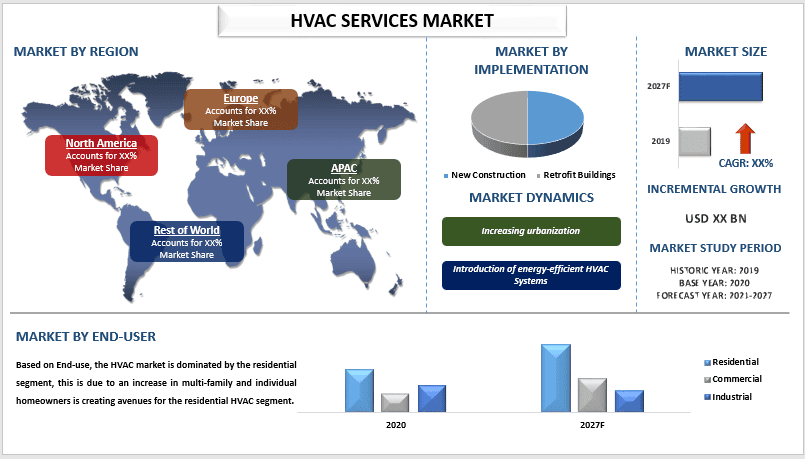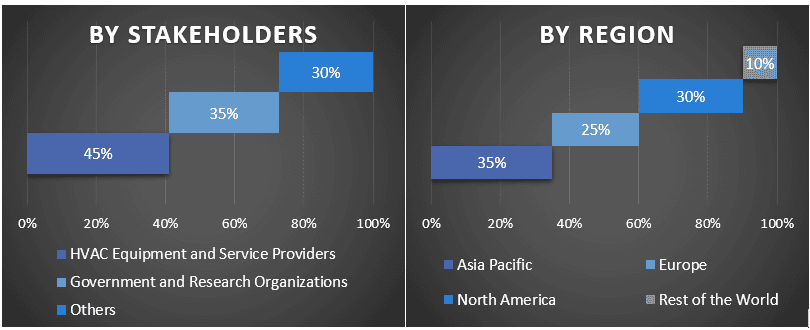- Home
- About Us
- Industry
- Services
- Reading
- Contact Us
HVAC Services Market: Current Analysis and Forecast (2021-2027)
Emphasis on Implementation (New Construction, Retrofit Building); End-Use (Residential, Commercial, Industrial); and Region/Country

Global HVAC Service Market is expected to grow at a CAGR of 7.0% during the forecast period. owing to the rising demand from emerging economies along with the rising purchasing power of the public and rapid urbanization. Some of the benefits of adopting HVAC services include energy-efficient, improved results, and lifespan, among others. According to the report by the International Energy Agency (IEA), Global energy demand from air conditioners is anticipated to triple by 2050, requiring new electricity capacity equivalent to the combined electricity capacity of the US, the EU, and Japan today.
Some of the major companies in the market are Ingersoll-Rand PLC, Carrier Corporation, Johnson Controls International PLC, Daikin Industries Ltd., Nortek Global HVAC, Lennox International In, Fujitsu General Ltd, Robert Bosch GmbH, Electrolux AB, Siemens, AGLG Electronics Inc, Honeywell International Inc.
Insights Presented in the Report
“Amongst, Implementation type, new construction category would account for the majority share during the forthcoming years”
Based on the implementation type, the market is segmented into new constructions and retrofit buildings. During the forecast period, the new construction segment is expected to hold the majority of the market. This is mainly driven due to rising investments in the development of commercial and residential construction projects. Moreover, increasing demand for commercial and residential buildings equipped with HVAC may drive segment growth. In addition, the growing tendency of residents towards structures that can be profitable may drive the growth of this segment.
“Amongst End-use, the residential segment is expected to witness the highest CAGR during the forecast period”
Based on end-use, the market is segmented into residential, commercial, and industrial. The residential market grabbed the majority of the market share in 2020. Increasing ownership of apartments and single-family homes creates opportunities for the residential HVAC segment. Moreover, the introduction of advanced residential air conditioners with advanced features such as corrosion resistance, auto humid control facility, and copper condenser are expected to contribute to the market growth.
“Asia Pacific to witness significant growth during the forecast period”
The Asia Pacific region dominated the HVAC services market. The key factor such as rapid urbanization; population growth and increased consumer disposable income are key success factors behind the region’s long-standing tremendous growth. Recently, the commercial sector has grown, creating prospects for future regional growth. Moreover, thriving construction activities in the commercial sector in India, Japan, South Korea, and China due to rapid urbanization is anticipated to propel the market growth in the forecast period.
Reasons to buy this report:
- The study includes market sizing and forecasting analysis validated by authenticated key industry experts.
- The report presents a quick review of overall industry performance at one glance.
- The report covers an in-depth analysis of prominent industry peers with a primary focus on key business financials, product portfolio, expansion strategies, and recent developments.
- Detailed examination of drivers, restraints, key trends, and opportunities prevailing in the industry.
- The study comprehensively covers the market across different segments.
- Deep dive regional level analysis of the industry.
Customization Options:
Global HVAC services market can further be customized as per the requirement or any other market segment. Besides this, UMI understands that you may have your own business needs, hence feel free to connect with us to get a report that completely suits your requirements.
Table of Content
Research Methodology for the Global HVAC Services Market Analysis (2021-2027)
Analyzing the historical market, estimating the current market, and forecasting the future market of the global HVAC services market were the three major steps undertaken to create and analyze the adoption of HVAC services in major regions globally. Exhaustive secondary research was conducted to collect the historical market numbers and estimate the current market size. Secondly, to validate these insights, numerous findings and assumptions were taken into consideration. Moreover, exhaustive primary interviews were also conducted, with industry experts across the value chain of the global HVAC services market. Post assumption and validation of market numbers through primary interviews, we employed a top-down/bottom-up approach to forecasting the complete market size. Thereafter, market breakdown and data triangulation methods were adopted to estimate and analyze the market size of segments and sub-segments of the industry pertains to. Detailed methodology is explained below:
Seek More Details About Research Methodology
Analysis of Historical Market Size
Step 1: In-Depth Study of Secondary Sources:
Detail secondary study was conducted to obtain the historical market size of the HVAC services market through company internal sources such as annual report & financial statements, performance presentations, press releases, etc., and external sources including journals, news & articles, government publications, competitor publications, sector reports, third-party database, and other credible publications.
Step 2: Market Segmentation:
After obtaining the historical market size of the HVAC services market, we conducted a detailed secondary analysis to gather historical market insights and share for different segments & sub-segments for major regions. Major segments are included in the report as an implementation type and end-user. Further country-level analyses were conducted to evaluate the overall adoption of testing models in that region.
Step 3: Factor Analysis:
After acquiring the historical market size of different segments and sub-segments, we conducted a detailed factor analysis to estimate the current market size of the HVAC services market. Further, we conducted factor analysis using dependent and independent variables such as various Implementation types, and end-user of HVAC services. A thorough analysis was conducted for demand and supply-side scenarios considering top partnerships, mergers and acquisitions, business expansion, and product launches in the HVAC services market sector across the globe.
Current Market Size Estimate & Forecast
Current Market Sizing: Based on actionable insights from the above 3 steps, we arrived at the current market size, key players in the global HVAC services market, and market shares of the segments. All the required percentage shares split, and market breakdowns were determined using the above-mentioned secondary approach and were verified through primary interviews.
Estimation & Forecasting: For market estimation and forecast, weights were assigned to different factors including drivers & trends, restraints, and opportunities available for the stakeholders. After analyzing these factors, relevant forecasting techniques i.e., top-down/bottom-up approach was applied to arrive at the market forecast about 2027 for different segments and sub-segments across the major markets globally. The research methodology adopted to estimate the market size encompasses:
- The industry’s market size, in terms of revenue (USD) and the adoption rate of HVAC services market across the major markets domestically
- All percentage shares, splits, and breakdowns of market segments and sub-segments
- Key players in the global HVAC services market in terms of solutions offered. Also, the growth strategies adopted by these players to compete in the fast-growing market
Market Size and Share Validation
Primary Research: In-depth interviews were conducted with the Key Opinion Leaders (KOLs) including Top Level Executives (CXO/VPs, Sales Head, Marketing Head, Operational Head, and Regional Head, Country Head, etc.) across major regions. Primary research findings were then summarized, and statistical analysis was performed to prove the stated hypothesis. Inputs from primary research were consolidated with secondary findings, hence turning information into actionable insights.
Split of Primary Participants in Different Regions

Market Engineering
The data triangulation technique was employed to complete the overall market estimation and to arrive at precise statistical numbers for each segment and sub-segment of the global HVAC services market. Data was split into several segments & sub-segments post studying various parameters and trends in the areas of implementation and end-user in the global HVAC services market.
The main objective of the Global HVAC Services Market Study
The current & future market trends of the global HVAC services market were pinpointed in the study. Investors can gain strategic insights to base their discretion for investments on the qualitative and quantitative analysis performed in the study. Current and future market trends determined the overall attractiveness of the market at a regional level, providing a platform for the industrial participant to exploit the untapped market to benefit from a first-mover advantage. Other quantitative goals of the studies include:
- Analyze the current and forecast market size of the HVAC services market in terms of value (USD). Also, analyze the current and forecast market size of different segments and sub-segments
- Segments in the study include areas of Implementation type and end-user
- Define and analysis of the regulatory framework for the HVAC services market industry
- Analyze the value chain involved with the presence of various intermediaries, along with analyzing customer and competitor behaviors of the industry
- Analyze the current and forecast market size of the HVAC services market for the major region.
- Major countries of regions studied in the report include Asia Pacific, Europe, North America, and Rest of the world
- Company profiles of the HVAC services market and the growth strategies adopted by the market players to sustain in the fast-growing market
- Deep dive regional level analysis of the industry
Related Reports
Customers who bought this item also bought










